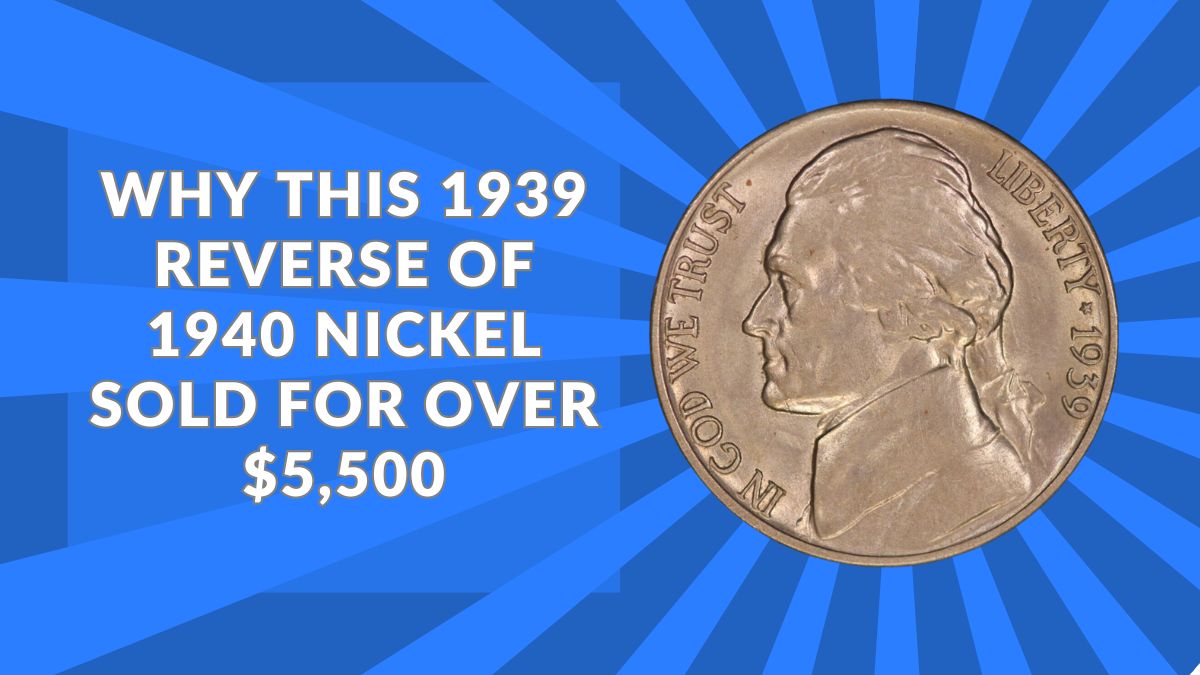The 1939 Reverse of 1940 Jefferson Nickel stands as a remarkable piece in numismatic history, captivating collectors with its unique design and rarity. Recently, this coin garnered significant attention when it sold for over $5,500 at auction.
This article delves into the factors contributing to its high value, exploring its distinctive features, historical context, and the nuances that make it a prized possession among enthusiasts.
Understanding the 1939 Reverse of 1940 Jefferson Nickel
In 1939, the U.S. Mint introduced a modification to the reverse design of the Jefferson Nickel. This change, known as the Reverse of 1940, featured enhanced details on Monticello, Thomas Jefferson’s esteemed residence.
The most notable improvement was the clearer and more defined depiction of Monticello’s steps, often referred to as Full Steps. This design aimed to provide a more detailed and aesthetically pleasing representation of the iconic building.
Key Features of the Reverse of 1940 Design
- Enhanced Monticello Steps: The Reverse of 1940 showcased six well-defined steps leading up to Monticello, a feature that became a focal point for collectors assessing the coin’s quality.
- Sharper Details: Overall, the design exhibited crisper lines and more intricate details compared to its predecessor, the Reverse of 1938.
Factors Influencing the Coin’s Value
Several elements contribute to the substantial value of the 1939 Reverse of 1940 Jefferson Nickel:
- Condition and Grade: Coins in Mint State (MS) condition, especially those graded MS67 or higher, are exceptionally rare and command higher prices. The presence of Full Steps further elevates the coin’s desirability.
- Rarity: While the 1939 Jefferson Nickel had a substantial mintage, specimens featuring the Reverse of 1940 with Full Steps are scarce, making them more valuable to collectors.
- Historical Significance: As a transitional design, the Reverse of 1940 marks an important evolution in the Jefferson Nickel series, adding to its appeal among numismatists.
Recent Auction Highlights
The market for the 1939 Reverse of 1940 Jefferson Nickel has seen notable sales, underscoring its value:
- MS68 Grade: An MS68 graded coin achieved a remarkable price, reflecting its pristine condition and rarity.
- MS67 Full Steps: Coins with this grade and the Full Steps designation have consistently realized prices in the range of $3,000 to $5,500, highlighting the premium placed on well-preserved examples.
Reverse of 1938 vs. Reverse of 1940
To appreciate the distinctions between the two designs, consider the following comparison:
| Feature | Reverse of 1938 | Reverse of 1940 |
|---|---|---|
| Monticello Steps | Less defined, often appearing worn | Sharply defined, clear Full Steps |
| Overall Detail | Softer features, less intricate | Crisper lines, enhanced detail |
| Collector Preference | Generally less sought after | Highly desirable, especially with Full Steps |
Identifying the Reverse of 1940
Collectors can distinguish the Reverse of 1940 by examining:
- Step Detail: Look for six distinct, unbroken steps on Monticello.
- Design Sharpness: The overall design should exhibit sharper lines and more intricate details compared to earlier versions.
Investment Potential
The 1939 Reverse of 1940 Jefferson Nickel represents a compelling investment opportunity due to:
- Appreciating Value: High-grade examples have shown a consistent increase in value over the years.
- Collector Demand: The coin’s unique features and historical significance ensure ongoing interest from collectors.
The 1939 Reverse of 1940 Jefferson Nickel embodies a blend of historical significance, rarity, and distinctive design elements that captivate collectors. Its recent sale for over $5,500 underscores the coin’s esteemed status in the numismatic community.
For enthusiasts and investors alike, this coin represents both a tangible piece of history and a valuable asset in a well-curated collection.
FAQs
What makes the 1939 Reverse of 1940 Jefferson Nickel unique?
Its enhanced design features, particularly the well-defined Monticello steps, distinguish it from earlier versions.
How can I identify a Full Steps designation?
A Full Steps designation is awarded to coins where Monticello’s steps are sharply defined with no interruptions.
Why are high-grade examples of this coin so valuable?
The combination of rarity, exceptional condition, and collector demand elevates the value of high-grade specimens.
Is the 1939 Reverse of 1940 Jefferson Nickel a good investment?
Given its historical significance and appreciating value, it is considered a prudent addition to a numismatic investment portfolio.
